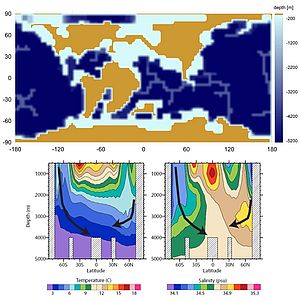Paleoclimate modelling


During Earths history, the climate system has experienced tremendous amplitudes of global climate change, such as transitions from icehouse to greenhouse states and back again or sea-level changes, regional changes such as glaciation, desertification, or tectonic uplift, and local changes in land cover or changes in freshwater discharge.
Spanning millions of years or just decades, the geologic record is a vital, but incomplete (e.g. by subduction or erosion) report of Earth's climate history. Therefore, efforts to understand past climate change apply and rely on numeric climate models that include the relevant physical and biogeochemical processes of the climate system. This includes modelling of the ocean and atmospheric circulation, as well as past pCO2 levels or biogeochemical nutrient cycling. Better understanding of feedback processes in and between the various compartments of Earth’s climate are a prerequisite for an improved view on past dynamics and anticipated future global change.
The Paleoclimate Modelling Group within the Paleoceanography research unit uses a hierarchy of climate and biogeochemical models to investigate the underlying mechanisms of past climate states. Numeric models help us to gain insights into the mechanisms and processes controlling and linking the various compartments of Earth’s climate system. In turn, the comparison between the output from these simulations and the paleoclimate proxy data provides the only way to validate current state-of-the-art climate models commonly used for future climate change scenarios. Currently, we use models of different complexity such as General Circulation Models (GCMs), models of intermediate complexity, and biogeochemical box models to investigate the longterm evolution of climate.
Research topics and associated projects:
SFB 754 - Unraveling the Onset and Spread of Cretaceous Anoxia
· Interglacial (~15 ka) hydrodynamics in the Gulf of Mexico
SPP Interdynamics – LOOP current variability – its relation to meridional overturning circulation and the impact of Mississippi discharge
· Lena River freshwater plume in the Laptev Sea
Changing Eurasian shelf seas – oceanic frontal systems and polynyas in the Laptev Sea
Projects:
Unraveling the Onset and Spread of Cretaceous Anoxia
Evolving carbon sinks in the young South Atlantic: Drivers of global climate in the early Cretaceous Greenhouse?
Contact
Dr. Sascha Flögel
email: sfloegel(at)geomar.de


